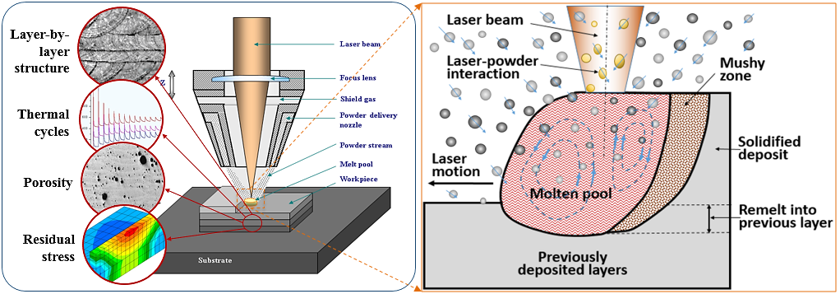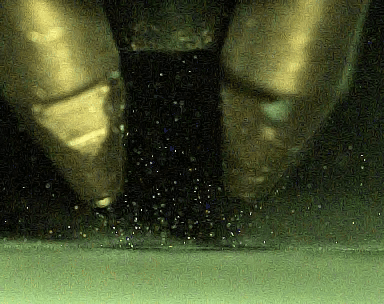The JMS group works on the cutting edge of materials science research and engineering. JMS conducts research on advanced materials and manufacturing methodologies with a focus on the interrelationship between material properties, microstructure, and the processing parameters used. In addition to research aimed at improving new materials and production techniques, the group performs extensive research work on the sustainability and environmental impact of advanced material use and production. This page contains an overview of some of the exciting areas of research happening at the JMS lab.
Engineering Novel Materials: Development & Characterization
Before advanced materials or innovative fabrication methods can be used in high technology applications, they must be developed and characterized – to push the boundaries, we must first learn where they are! To that end, the overall project of Materials Science begins with discovering new viable materials and learning how to use existing materials in new ways.
Magnesium Alloys
| The group is investigating the use of magnesium alloys in engineering applications where they have previously not been practicable. The advantage of magnesium alloys is that they are one of the lightest engineering alloys available, which means that they have great potential for automotive, aerospace, and portable electronics applications. The challenge of magnesium alloys, however, is that they are very brittle compared to materials like stainless steel or aluminum. This is because of the limited number of slip systems in magnesium’s hexagonal close packed crystal structure, as opposed to the cubic crystal structure of steel and aluminum. In an effort to extend the applicability of magnesium as an engineering material, characterization research of magnesium alloys is ongoing. The goal is to better understand the connection between the microstructure and bulk mechanical properties of these materials so as to learn how to enhance their desirable traits and, specifically, reduce their brittleness. An important part of this characterization effort is material deformation testing with in situ imaging. That is, while undergoing deformation tests these materials can be imaged with transmission & scanning electron microscopes (TEM & SEM), providing a real-time look at the internal deformation of the materials and, thus, important insight into the microstructure—mechanical property relationship. | |
|
|
|
High Entropy Oxides
| Following the explosion in the last decade of the field of high entropy alloys, alloys composed of equimolar amounts of five or more metals, attention is turning to the potential of similar developments in ceramics. The JMS group conducts research on the possibilities presented by these high entropy oxides (HEO). High entropy stabilization allows for the creation of material systems with complexities greater than was once thought possible. This allows for the exploration of materials which include greater numbers of elements, thereby expanding the available “composition space” in which to develop materials with interesting properties. Due to high entropy stabilization, HEOs exhibit the behavior of having a reversible phase transformation, moving very easily between two phase states with minimal processing. For example, an HEO system can radically change its phase state with just a heat treatment and, crucially, reverse such a change in a similar manner. The possible industrial applications are considerable, but right now HEOs are in their infancy and research on them consists primarily in looking at the fundamentals of these materials. In engineering their microstructures to look at the fundamental science underlaying their properties, the question to be answered is: “how does the microstructure affect the phase transformation?” The JMS group is attempting to answer that question. An HEO studied by the group is one composed of oxides of cobalt, copper, magnesium, nickel, and zinc: (Co, Cu, Mg, Ni, Zn)O. To produce these materials, ceramic nano-powders are mixed with a planetary ball mill and then consolidated into a part via sintering – primarily spark plasma sintering (SPS), as it is good at retaining nanoscale microstructures. The HEO is then submitted to heat treatment and quenching. Finally, X-ray diffraction (XRD) is used to examine the phase states of the material. An intriguing development is that HEO materials with very fine (nano) scale microstructures have markedly different phase behavior than the same material with coarser microstructures. | |
 |
|
Additive Manufacturing
Additive manufacturing (AM), is a catch-all name to describe a variety of fabrication techniques which work by building three-dimensional objects by the iterative addition of successive thin layers of material. It is often colloquially known as 3D printing. The JMS group performs extensive research on all stages of production of a type of AM called directed energy deposition (DED). In essence, DED consists of building subsequent layers one atop another by selectively depositing powdered material upon the existing layer and simultaneously fusing it to that substrate in one go.
Powder
| The process of DED begins with the powders that are used in the production of the AM parts. There are many different ways to produce the powders used in DED, among them: gas atomization (GA), rotary atomization (RA), plasma rotating electrode process (PREP), and plasma atomization (PA). Each powder production method has the potential to produce powders with different characteristics (such as variability in powder size and powder shape) which can then impact the characteristics of the objects manufactured with them. Thus, the JMS group’s AM research begins with powder production, including experimentation on in-house powder atomization techniques. Additionally, the group investigates post-production processing methods for improving powder quality, consistency, and uniformity with methods such as ball-milling and cryomilling, among others. | |
 |
 |
Processing
Directed Energy Deposition: Laser Engineered Net Shaping (LENS®)
| JMS uses a DED technique developed by Sandia National Laboratories called Laser Engineered Net Shaping (LENS), which can fabricate (traditionally) metal parts directly from CAD models. The process functions by using a laser to melt together newly deposited powdered material to the existing substrate of material. Due to the precise nature of additive manufacturing, the specifics of how builds are fabricated play a large role in the properties of the finished product. The JMS group explores in-depth the relationship between LENS processing parameters and the properties of objects created with them. Some of these processing parameters include: laser power (and thus, amount of energy used to fuse powder to substrate), laser scan speed (how quickly the powder—laser nozzle traverses the build’s surface in depositing each layer), hatch spacing regime (the geometry of the path followed by the nozzle in its deposition, i.e., the ‘hatch-space’ between each traversal of the nozzle), working distance (how far from the substrate the nozzle is held during deposition, which affects the dynamics of both the laser—material interaction and the geometry of the powder cone), and pulsed laser settings (to see whether or not non-constant energy application can impact the powder fusion behavior in a desirable way). Due to the high degree of complexity in the thermo-mechanical interactions between the laser beam, deposited powder, previously deposited layers, and the melt pool (where the substrate is melted by the laser to accept new powdered material), the mechanical properties of builds can vary significantly depending on the particular set of processing parameters used. Therefore, the JMS group expends substantial scientific effort in understanding all of the complicated relationships at play in AM so as to be able to precisely determine methods to reliably produce parts with favorable and consistent physical properties. | |
 |
 |
Non-Conventional AM Materials
| A fertile area of AM research lies in expanding the scope of materials which can be fabricated in this manner. In addition to working with traditional engineering materials used in AM (such as stainless steel, titanium alloys, ‘inconel’ nickel superalloys, etc.), the JMS group is exploring the usage of other non-traditional materials in LENS manufacturing. Aluminum, for example, is notoriously difficult to process additively due to its very high reflectivity. Additionally, the group is pursuing additive manufacturing for ceramics, which can be hard to machine because of their hardness and high melting point. With intriguing potential uses in energy-based applications, high quality & reliable ceramic additive manufacturing is an exciting goal and ongoing project of the JMS group. | |
 |
 |
Green Engineering: Sustainability and Recyclability of Advanced Manufacturing Techniques
| As a part of its commitment to environmental sustainability and ecological responsibility, the JMS group conducts research on a variety of factors relating to the environmental impact of advanced materials engineering and additive manufacturing. The group studies the recyclability of powders and the AM components made from them to learn how powders can be reused and whether or not parts can be sustainably turned back into powders for reuse in the AM of new parts. Additional topics of interest in this area include: lifecycle assessments of AM components; the total impact of AM production systems (e.g., in terms of energy expenditure and water consumption); and the possibility of recycling waste (e.g., industrial waste, scrap, etc.) into powders which could be used to AM fresh parts, thereby significantly broadening the scope of discarded materials which could be efficaciously recycled. | |
 |
|